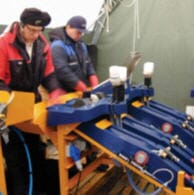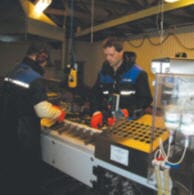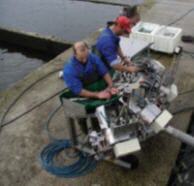Based on the experience that the Norwegian industry has gleaned in the use of specific methods and vaccination machines, this article is an attempt to evaluate some of the current machines (as well as manual vaccination). Because of the risk of side effects due to injection vaccination, salmon and trout smolts should ideally weigh more than 40 g at vaccination. As all of the machines considered here use fish of this size, product information related to fish size will not be discussed.
| Basic information | |||
|
Name
|
Producer
|
Approx. cost price in 2005 (Euro)
|
Produced since
|
|
Manual vaccination
(assuming four vaccinators)
|
Several producers of needles and syringes
|
500 (excl. compressed air)
5,500 (incl. compressed air)
|
Pre-1980
|
|
Lumic LV4
|
Lumic AS
5690 Lundegrend
|
30,000
|
1999
|
|
NFT 10
|
Nordic Fish Tech AB, Gothenburg
|
47,000
|
2003
|
|
EasyVac 8000
|
Rossi International
Aasmund Torvik
6099 Fosnavg
|
26,000
|
1994
|
There is most experience with manual vaccination of salmon and rainbow trout. Simple syringes that do not use compressed air are the cheapest, but they are labour intensive and put a strain on the hands of the vaccinators. Syringes that use compressed air cost more at around EUR1,300 each, but they place less strain on the vaccinator and allow for a higher vaccination rate.
The machines from Lumic are currently the most widely used machines for vaccination of salmon in Norway. Lumic entered the market with a 2-line vaccination machine in 1992. Following further development and improvement, it was launched as a 4-line machine, the Lumic LV4, and this is currently the best selling machine.
Nordic Fish Tech has been producing machines for the fishing industry for a number of years, and its first vaccination machine was introduced at AquaNor in 2003. So far, only a few machines have been sold in Norway. It is sold mainly to fish farmers in the Mediterranean area. The EasyVac 8000 (formerly called Thormed 8000) was developed by Rossi International in Denmark in 1994. The technology has been developed from the first vaccination machine, the SpinoVac 7000, which entered the market in 1984. The machine is sold with 1, 2, 3, 4 or 6 vaccination units. Thirty-three machines were sold in Norway in the 1990's, and it is still available.
| Vaccination rate, labour requirement and functionality | ||||||
|
Name
|
No. lines/ Injection units
|
Rate (according to producer).
No. fish/hour
|
Average rate (according to user). No. fish/ hour
|
No. of vaccinators/
operators |
Sorted
by size
|
Injection
point/depth regulated according to fish size
|
|
Manual
vaccination
|
Free choice,
often 4
|
-
|
10000
2500 per man
|
Free choice,
often 4
|
No
|
Yes
No
|
|
Lumic LV4
|
4
|
9000
|
7000
|
2
|
No
|
No
No
|
|
NFT 10
|
2
|
7000
|
6-7000
|
2
|
Yes
|
Yes
Yes
|
|
EasyVac 8000
|
4
|
8000
|
7000
|
2
|
No
|
No
No
|
Manual vaccination
In the case of manual vaccination, the vaccinator usually places the fish in a belly-up position for vaccination. Some vaccinators prefer to have the fish on its side on a table during injection. The author is not aware of any studies where the two techniques have been compared. Professional vaccinators usually use compressed air syringes in order to reduce the strain on the vaccinators and achieve a higher vaccination rate.
Experience shows that manual injection vaccination gives very good results as regards the point of injection and vaccine deposition. However, the human factor is key to the result and, in practice, a tired or stressed manual vaccinator will produce a poorer result than that achieved with machine vaccination. Manual vaccination is tiring work with a far greater risk of self-injection than is the case with machine vaccination.
|
Prerequisites for a good result
|
Fresh fish
|
|
Vaccine at correct temperature
|
Can be kept in contact with body or in a warm room/tent
|
|
Overview of vaccination process
|
Good
|
|
Adjust point of injection
|
Depends on vaccinators accuracy and alertness
|
|
Adjust needle angle
|
Possible, desirability of injection at 90 degrees
|
|
Adjust depth of injection
|
Determined on the basis of the needle length
|
|
Adjust amount of vaccine
|
Easily regulated
|
|
Replacement of needles and syringes
|
Easily accessible
|
|
Risk of self-injection
|
Yes
|
Conclusion
 The Lumic LV4 in use. Photo: Arild Kollevg. |
Manual vaccination can be a quick and reliable vaccination method that does not require the fish group to be well sorted. The result depends more on the vaccinator's abilities than is the case with machine vaccination. The method is not optimal in terms of working environment, especially as regards physical strain on the hands and the risk of self-injection.
Lumic LV4
The Lumic LV4 has four vaccination lines which are operated by two people. The anaesthetised fish are lifted out of a line and placed head first into the vaccination chute. The fish slide down a partially enclosed chute into the injection chamber where they are stopped by a cushion. Fish which enter on their back are turned so that their belly points down. The fish are injected intraperitoneally from below at a 45-degree angle. At the start of the chute is a hatch which closes when the fish is being vaccinated. This prevents two fish from coming in at the same time.
|
Prerequisites for a good result
|
The fish must be sorted before vaccination.
The fish must be placed head first into the vaccination chute |
|
Vaccine at correct temperature
|
Yes
|
|
Overview of vaccination process
|
Operator cannot see the vaccination process
|
|
Adjust point of injection
|
Adjustment is possible, but accurate adjustment is difficult
with older machines. Todays machines are improved in this respect |
|
Adjust needle angle
|
Not possible
|
|
Adjust depth of injection
|
This is done through choice of needle length
|
|
Adjust amount of vaccine
|
Acceptable
|
|
Replacement of needles and syringes
|
Acceptable as regards accessibility
|
|
Risk of self-injection
|
Very low
|
Conclusion
The Lumic LV4 provides a high rate of vaccination and is reliable, provided that the fish are well sorted, that the operator feeds the machine correctly and that the machine is correctly adjusted. If the fish are uneven in size, the point of injection will vary. The machine's weakness is that it is difficult to accurately adjust the point of injection.
The injection depth is the same regardless of whether the fish is large or small, and the vaccination process is hidden from the view of the operator so that any mistakes are not discovered, unless the operator is really on the lookout for them. Development work in the newer machines has made it possible to adjust the point of injection freely, with no fixed intervals, and this function can also be installed in older machines.
NFT 10
 Fish being fed through the NFT 10 vaccination machine. Photo: Arild Kollevg. |
The NFT 10 both sorts and vaccinates the fish. The fish can be sorted into four sizes, based on their length, and the machine can be adjusted so that the smallest fish are not vaccinated. Two operators place the fish on the side of an inclined belt, and the speed of the belt is controlled. On their way to the vaccination chamber, the length of the fish is measured, and both the point and depth of injection are adjusted to take account of fish size.
The two vaccination units inject the fish quickly as the needle is inserted and withdrawn using a compressed air piston. It is the speed of the operators that determines how many fish are vaccinated. The machine senses the parts of the belt where there are no fish, and it only injects where there are fish. If the supply of vaccine stops or if air gets into the vaccine, the machine will stop after three fish have been vaccinated. The producer considered that glass syringes were too fragile and now uses a metal pump to allocate the correct dosage of vaccine.
|
Prerequisites for a good result
|
Fresh fish; must be placed correctly on the table
|
|
Vaccine at correct temperature
|
Yes. Hoses and the vaccine are kept at the correct temperature
|
|
Overview of vaccination process
|
The operator cannot see the vaccination process
|
|
Adjust point of injection
|
Regulation is possible to take account of both the length and the breadth of the fish
|
|
Adjust needle angle
|
Not possible
|
|
Adjust depth of injection
|
The depth of injection is determined by the size of the fish
|
|
Adjust amount of vaccine
|
This is done using chambers with different volumes
|
|
Replacement of needles and syringes
|
Acceptable as regards accessibility
|
|
Risk of self-injection
|
Very low
|
Conclusion
 The EasyVac 8000 in operation. Photo: Rossi International. |
The NFT 10 is a new sorting and vaccination machine which is technically sound and provides good precision. The machine gives good results when the fish are placed correctly on the belt and the machine is correctly adjusted. It is a great advantage that the depth of injection is adjusted to take account of the size of each fish.
EasyVac 8000
The EasyVac 8000 can be supplied with 1, 2, 3, 4, 6 or more vaccine units. This machine has four vaccination units operated by two operators. The fish is placed on its side, nose first, in the vaccination chute where it slides down until it is stopped by a cushion and held firmly in place by slight pressure from the side. The injection takes place from the side, and it is possible to adjust the angle of the needle, the injection depth and the point of injection. The injection depth is regulated on the machine and not by changing needles. The operator is able to observe the vaccination process so that any errors can be quickly identified and corrective action taken.
|
Prerequisites for a good result
|
The fish must be sorted before vaccination. The fish must be placed correctly in the chute
|
|
Vaccine at correct temperature
|
Not standard. Available as extra equipment
|
|
Overview of vaccination process
|
Yes
|
|
Adjust point of injection
|
Regulation is possible to take account of both the length and breadth of the fish
|
|
Adjust needle angle
|
It is possible to set the angle at 15, 30, 45 and 90 degrees
|
|
Adjust depth of injection
|
The injection depth can be regulated, but it is the same for both small and large fish
|
|
Adjust amount of vaccine
|
Acceptable
|
|
Replacement of needles and syringes
|
Acceptable as regards accessibility
|
|
Risk of self-injection
|
Very low
|
Conclusion
EasyVac 8000 provides a high rate of vaccination, provided that the fish are well sorted, that the operator feeds the machine correctly and that the machine is correctly adjusted. If the fish are uneven in size, the point of injection will vary according to the size of the fish.
Overall Summary
All of the methods described above for the vaccination of fish function in an acceptable way provided that certain conditions are met. The EasyVac 8000 and Lumic LV4 require the fish to be of the same size and correct adjustment of the machine is essential in order to achieve good results.
The NFT 10 also requires correct adjustment of the machine and that the fish are placed correctly on the belt in order to achieve good results. Of the machines described, this is the only one which both sorts and vaccinates, and where the point and depth of injection are adjusted to take account of the size of the fish.
November 2006



